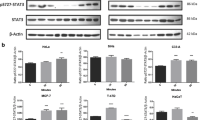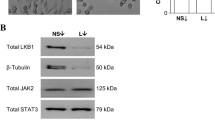Abstract
A mimic of phosphorylated prolactin (S179D PRL) inhibits mouse normal mammary HC11 cell proliferation through the upregulation of the vitamin D receptor (VDR) and p21. Here, we investigated whether S179D PRL also inhibited growth of human breast cancer MCF7 cells via VDR and p21. Western blots showed that S179D PRL upregulated VDR and p21 after the cells were incubated with S179D PRL for 3 days. These effects were blocked by the MAP kinase blocker PD98059 (25 μM), indicating that MAPK plays a role in VDR and p21 upregulation. To confirm whether VDR contributes to p21 upregulation, we used two constructs that express luciferase. One (p21 VDRE Luc) has the vitamin D response element (VDRE) in the p21 promoter region; the other (p21 NO-VDRE Luc) does not. The results show that S179D PRL upregulated p21 VDRE Luc activity in p21 VDRE Luc-transfected cells more than in p21 NO-VDRE-transfected cells, indicating that S179D PRL upregulated p21 via VDR. A cell proliferation assay showed that S179D PRL inhibits cell proliferation in a dose-dependent manner.




Similar content being viewed by others
References
Ueda EK, Soares CR, Bartolini P, DeGuzman A, Lorenson MY, Walker AM. A molecular mimic of phosphorylated prolactin (S179D PRL) secreted by eukaryotic cells has a conformation with an increased positive surface charge compared to that of unmodified prolactin. Biochemistry. 2009;48:6887–97.
Wu W, Coss D, Lorenson MY, Kuo CB, Xu X, Walker AM. Different biological effects of unmodified prolactin and a molecular mimic of phosphorylated prolactin involve different signaling pathways. Biochemistry. 2003;42:7561–70.
Kuo CB, Wu W, Xu X, Yang L, Chen C, Coss D, et al. Pseudophosphorylated prolactin (S179D PRL) inhibits growth and promotes beta-casein gene expression in the rat mammary gland. Cell Tissue Res. 2002;309:429–37.
Lee EJ, Moon GS, Choi WS, Kim WJ, Moon SK. Naringin-induced p21 waf1-mediated G (1)-phase cell cycle arrest via activation of the Ras/Raf/ERK signaling pathway in vascular smooth muscle cells. Food Chem Toxicol. 2008;46:3800–7.
Luo Y, Hurwitz J, Massague J. Cell cycle inhibition by independent CDK and PCNA binding domains in p21 Cip1. Nature. 1995;375:159–61.
Wu W, Chen YH, Ueda E, Tan DY, Bartolini P, Walker AM. Different forms of prolactin have opposing effects on the expression of cell cycle regulatory proteins in differentiated mammary epithelial cells. Oncol Res. 2006;16:75–84.
Wang Q, Lee D, Chandraratna RAS, Sysounthone V, Christakos S, Korah R, et al. 1,25-Dihydroxyvitamin D3 and retinoic acid analogues induce differentiation in breast cancer cells with function-and cell- specific additive effects. Breast Cancer Res Treat. 2001;67:157–68.
Colston KW, Hansen CM. Mechanisms implicated in the growth regulatory effects of vitamin D in breast cancer. Endocr Relat Cancer. 2002;9:45–59.
Chouvet C, Berger U, Coombes R. 1,25-Dihydroxyvitamin, D3 inhibitory effect on the growth of two human breast cancer cell lines (MCF7, BT-20). J Steroid Biochem. 1986;24:373–6.
Jensen SS, Madsen MW, Lukas J, Bartek J, Binderup L. Sensitivity to growth suppression by 1alpha, 25-dihydroxyvitamin D(3) among MCF-7 clones correlates with vitamin D receptor protein induction. J Steroid Biochem Mol Biol. 2002;81:123–33.
Gaschott T, Wachtershauser A, Steinhiber D, Stein J. 1,25-Dihydroxycholecalciferol enhances butyrate-induced p21(Waf1/Cip1) expression. Biochem Biophys Res Commun. 2001;283:80–5.
Liu M, Lee MH, Cohen M, Bommakanti M, Freeman LP. Transcriptional activation of the cdk inhibitor p21 by vitamin D3 leads to the induced differentiation of the myelomonocytic cell line U937. Genes Dev. 1996;10:142–53.
Wang Q, Lee D, Sysounthone V, Chandraratna RAS, Christakos S, Korah R, et al. 1,25-Dihydroxyvitamin D3 and retinoic acid analogues induce differentiation in breast cancer cells with function-and cell-specific additive effects. Breast Cancer Res Treat. 2001;67:157–68.
Colston KW, Hansen CM. Mechanisms implicated in the growth regulatory effects of vitamin D in breast cancer. Endocr-Relat. Cancer. 2002;9:45–59.
Buras RR, Schumaker LM, Davoodi F, Brenner RV, Shabahang M, Nauta RJ, et al. Vitamin D receptors in breast cancer cells. Breast Cancer Res Treat. 1994;31:191–202.
Mezzetti G, Barbiroli B, Oka T. 1,25-Dihydroxycholecalciferol receptor regulation in hormonally induced differentiation of mouse mammary gland in culture. Endocrinology. 1987;120:2488–93.
Colston K, Berger U, Wilson P, Hadcocks L, Naeem I, Earl H, et al. Mammary gland 1,25-dihydroxyvitamin D3 receptor content during pregnancy and lactation. Mol Cell Endocrinol. 1988;60:15–22.
Chen TJ, Kuo CB, Tsai KF, Liu JW, Chen DY, Walker AM. Development of recombinant human prolactin receptor antagonists by molecular mimicry of the phosphorylated hormone. Endocrinology. 1998;139:609–16.
Schroeder MD, Brockman JL, Walker AM, Schuler LA. Inhibition of prolactin (PRL)-induced proliferative signals in breast cancer cells by a molecular mimic of phosphorylated PRL, S179D-PRL. Endocrinology. 2003;144:5300–7.
Davis D, Pintucci G, Stern A. MAPK-dependent expression of p21 waf1 and p27 kip1 in PMA-induced differentiation of HL60 cells. FEBS Lett. 2000;472:50–2.
Liu Y, Martindale JL, Gorospe M, Holbrook NJ. Regulation of p21 waf1/cip1 expression through mitogen-activated protein kinase signaling pathway. Cancer Res. 1996;56:31–5.
Lessor T, Yoo JY, Hamburger AW. Regulation of heregulin beta-1-induced differentiation in a human breast carcinoma cell line by the extracellular-regulated kinase (ERK) pathway. J Cell Biochem. 1998;70:587–95.
Ho TC, Chen SL, Yang YC, Chen CY, Feng FP, Hsieh JW, et al. 15-Deoxy-delta 12,14-prostaglandin J2 induces vascular endothelial cell apoptosis through the sequential activation of MAPS and p53. J Biol Chem. 2008;283:30273–88.
Chin YE, Kitagawa M, Su WC, You ZH, Iwamoto Y, Fu XY. Cell growth arrest and induction of cyclin-dependent kinase inhibitor p21 waf1/cip1 mediated by STAT1. Science. 1996;272:719–22.
Wyszomierski SL, Yeh J, Rosen JM. Glucocorticoid receptor/signal transducer and activator transcription 5 (STAT5) interactions enhances STAT5 activation by prolong STAT5 DNA binding and tyrosine phosphorylation. Mol Endocrinol. 1999;13:330–43.
Barsony J, Pike JW, DeLuca HF, Marx SJ. Immunocytology with microwave-fixed fibroblasts shows 1 alpha, 25-dihydroxyvitamin D3-dependent rapid and estrogen-dependent slow reorganization of vitamin D receptors. Cell Biol. 1990;111:2385–95.
Wu W, Ginsburg E, Vonderhaar BK, Walker AM. S179D prolactn increases vitamin D receptor and p21 through up-regulation of short 1b prolactin receptor in human prostate cancer cells. Cancer Res. 2005;65:7509–15.
Huang KT, Walker AM. Long term increased expression of the short form 1b prolactin receptor in PC3 human prostate cancer cells decreases cell growth and migration, and causes multiple changes in gene expression consistent with reduced invasive capacity. Prostate. 2009;8:37–47.
Acknowledgments
The authors would like to thank Dr. Ameae Walker (University of California, Riverside) for her support in experiments. This work was supported by the Science and Development Plan of the Beijing Education Committee (KM200910025008). The authors would also like to thank Dr. Leopard Freeman (Memorial Sloan-Kettering Cancer Center) for his generosity in providing constructs.
Author information
Authors and Affiliations
Corresponding author
Additional information
Wenjie Xie and Yan He contributed to this work equally.
Rights and permissions
About this article
Cite this article
Xie, W., He, Y., Huo, D. et al. A mimic of phosphorylated prolactin inhibits human breast cancer cell proliferation via upregulation of p21 waf1. Med Oncol 27, 1340–1345 (2010). https://doi.org/10.1007/s12032-009-9386-6
Received:
Accepted:
Published:
Issue Date:
DOI: https://doi.org/10.1007/s12032-009-9386-6




